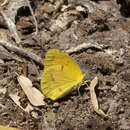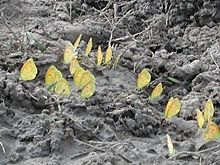en
names in breadcrumbs


Abaeis nicippe ye una especie de caparina, de la familia de les Pieridaeridae, que foi descrita orixinalmente col nome de Papilio nicippe, por Cramer, en 1779, a partir d'exemplares procedentes d'USA, VA.[2][3]
Abaeis nicippe ta distribuyida ente les rexones Neotropical, Neártica y foi reportada en Costa Rica, Méxicu, Puertu Ricu, Estaos Xuníos.[4]
Abaeis nicippe ye una especie de caparina, de la familia de les Pieridaeridae, que foi descrita orixinalmente col nome de Papilio nicippe, por Cramer, en 1779, a partir d'exemplares procedentes d'USA, VA.
Eurema nicippe ist ein in Nord- und Mittelamerika vorkommender Schmetterling (Tagfalter) aus der Familie der Weißlinge (Pieridae).
Die Falter erreichen eine Flügelspannweite von 35 bis 57 Millimetern.[1] Zwischen den Geschlechtern besteht kein Sexualdimorphismus. Die Grundfarbe aller Flügeloberseiten ist gelb bis gelborange. Von der Mitte des Vorderrandes und des Apex der Vorderflügel verläuft ein breites schwarzbraunes Band entlang des Saums, das sich auf den Hinterflügeln kräftig fortsetzt. Ein schmaler, länglicher schwarzer Diskalfleck hebt sich deutlich ab. Die Flügelunterseiten sind nahezu zeichnungslos, lediglich einige sehr kleine bräunliche oder rötliche Flecke sind zuweilen vorhanden. In der Sommersaison sind sie gelb, während sie in der Wintersaison ockerfarben bis hell rötlich braun gefärbt sind.
Die Eier haben die Form eines länglichen Rotationsellipsoids und eine weißliche bis gelbliche Farbe. Junge Raupen sind grün gefärbt und zeigen viele kleine weiße Punkte sowie einen weißen Seitenstreifen. Ausgewachsenen sind sie ebenfalls grün gefärbt und haben einen weißgelben Seitenstreifen. Die gesamte Körperoberfläche ist mit sehr kurzen hellen Härchen überzogen. Die Puppe ist als Gürtelpuppe ausgebildet und hat zunächst eine grüne Farbe, von der sich eine weißliche Seitenlinie und sehr kleine schwarze Punkte abheben. Der Kopf ist spitz, die Flügelscheiden ragen hervor. Kurz vor dem Schlüpfen scheint das Flügelmuster bereits durch die Flügelscheiden hindurch.
Das Vorkommensgebiet der Art erstreckt sich von Kalifornien, Texas und Florida Richtung Süden bis nach Mittelamerika einschließlich der Großen Antillen.[2] Einzelne nach Norden gewanderte Exemplare wurden in Wyoming und Ontario gefunden.[3]
Eurema nicippe besiedelt in erster Linie offene Feldlandschaften, Trockengebüschzonen, Ödländereien, Gärten und Straßenränder.
Die Falter fliegen in mehreren aufeinander folgenden Generationen das ganze Jahr hindurch. Die Spätsommergeneration überwintert in den meisten Vorkommensgebieten als Falter. Beide Geschlechter saugen zur Nahrungsaufnahme gerne an Blüten, beispielsweise an Behaartem Zweizahn (Bidens pilosus) oder Wandelröschenarten (Lantana). Zuweilen suchen sie in großer Anzahl feuchte Erdstellen auf, um Flüssigkeit und Mineralstoffe aufzunehmen. Die Weibchen legen die Eier einzeln an der Unterseite von Blättern oder an Blütenknospen der Nahrungspflanzen ab.[3] Die Raupen leben einzeln und ernähren sich von den Blättern verschiedener Hülsenfrüchtler (Fabaceae), dazu zählen Kassien (Cassia) und Klee (Trifolium).[2] Die Falter haben mitunter einen sehr gemächlichen Flugstil (schläfrig), weshalb sie im englischen Sprachgebrauch als Sleepy Orange bezeichnet werden.
Eurema nicippe ist ein in Nord- und Mittelamerika vorkommender Schmetterling (Tagfalter) aus der Familie der Weißlinge (Pieridae).
Eurema nicippe, the sleepy orange, is a North American butterfly in the family Pieridae. It is also found in the West Indies, Costa Rica and Belize.

The sleepy orange is a bright orange butterfly with the upperside of the wings having wide black borders. The forewing costal margin has a small, narrow black spot. Some people think that the sleepy orange got its name from the black spot that looks like a closed eye; others say that the sleepy orange is a misnomer because, when disturbed, the butterfly has a very rapid flight. The underside of the wings varies seasonally: summer forms are bright yellow with brick-red markings, while winter forms are browner and more heavily marked. It has a wingspan of 13⁄8–21⁄4 inches (35–57 mm).
The sleepy orange may be found in or around old fields, roadsides, woods edges, swamps, wet meadows, open woodlands, margins of ponds, waterways, and valleys.
The eggs are pale greenish yellow and turn red just before hatching. They are laid on the underside of the host plant leaves, or sometimes on flowers. The larva is fuzzy and grayish green, with a whitish-yellow side stripe. The chrysalis varies from green to brownish black. Adult sleepy oranges migrate south to spend the winter. They have two to four broods per year.
Eurema nicippe, the sleepy orange, is a North American butterfly in the family Pieridae. It is also found in the West Indies, Costa Rica and Belize.
Eurema nicippe (antes considerado Abaeis nicippe) es una especie de mariposa, de la familia de las piérides, que fue descrita originalmente con el nombre de Papilio nicippe, por Cramer, en 1779, a partir de ejemplares procedentes de USA, VA.[2][1]
Eurema nicippe está distribuida entre las regiones Neotropical, Neártica y ha sido reportada en Costa Rica, México, Puerto Rico, Estados Unidos.[3]
Eurema nicippe (antes considerado Abaeis nicippe) es una especie de mariposa, de la familia de las piérides, que fue descrita originalmente con el nombre de Papilio nicippe, por Cramer, en 1779, a partir de ejemplares procedentes de USA, VA.
Eurema nicippe
La Piéride orangée (Eurema nicippe) est un insecte lépidoptère de la famille des Pieridae.
Eurema nicippe a été nommé par Pieter Cramer en 1779.
Synonyme : Abaeis nicippe (Cramer, 1779); Papilio nicippe Cramer, [1779]; Terias nicippe ; Godman et Salvin, [1889]; Eurema nicippe flava ; Dyar, 1903[1],[2].
La Piéride orangée est un papillon de taille moyenne (son envergure varie de 35 à 57 mm) au dessus de couleur orange vif largement bordé de noir aux antérieures comme aux postérieures[4],[5].
Le revers est de couleur jaune orangé.
Dans le sud du Texas il vole toute l'année en quatre ou cinq générations[4].
Plus au nord c'est un migrateur dans presque l'ensemble du territoire des USA et exceptionnellement jusques dans le sud de l'Ontario au Canada[4],[5].
Les plantes hôtes de sa chenille sont des Cassia et des Trifolium[1].
La Piéride orangée réside au Mexique, au Costa Rica et dans le sud des USA[1]
Il est migrateur habituel dans tout le sud et le centre des USA, mais pas dans les zones montagneuses, assez rarement dans les états limitrophes du Canada avec comme limite le sud de l'Ontario au Canada [2],[5].
Il réside dans les friches, les jardins, le long des routes et dans d'autres habitats.
Pas de statut de protection particulier[2].
Ce papillon figure sur une émission de Cuba de 1997 (valeur faciale : 10 c.).
Eurema nicippe
La Piéride orangée (Eurema nicippe) est un insecte lépidoptère de la famille des Pieridae.
Eurema nicippe est papilio familiae Pieridarum, in America Septentrionali endemicus.
Latitudo alarum est 1 3/8 ad 2 1/4 unciae.
Eurema nicippe in agris vetustioribus, marginibus viarum silvarumque, paludibus, pratis humidibus, silvis apertis, marginibus stagnorum, viis aquatilibus, et vallibus habitat.
Inter plantas quibus larvae vescuntur sunt:
Eurema nicippe est papilio familiae Pieridarum, in America Septentrionali endemicus.
Latitudo alarum est 1 3/8 ad 2 1/4 unciae.
Abaeis nicippe is een vlindersoort uit de familie van de Pieridae (witjes), onderfamilie Coliadinae.
Abaeis nicippe werd in 1779 beschreven door Cramer.[1]
Bronnen, noten en/of referenties